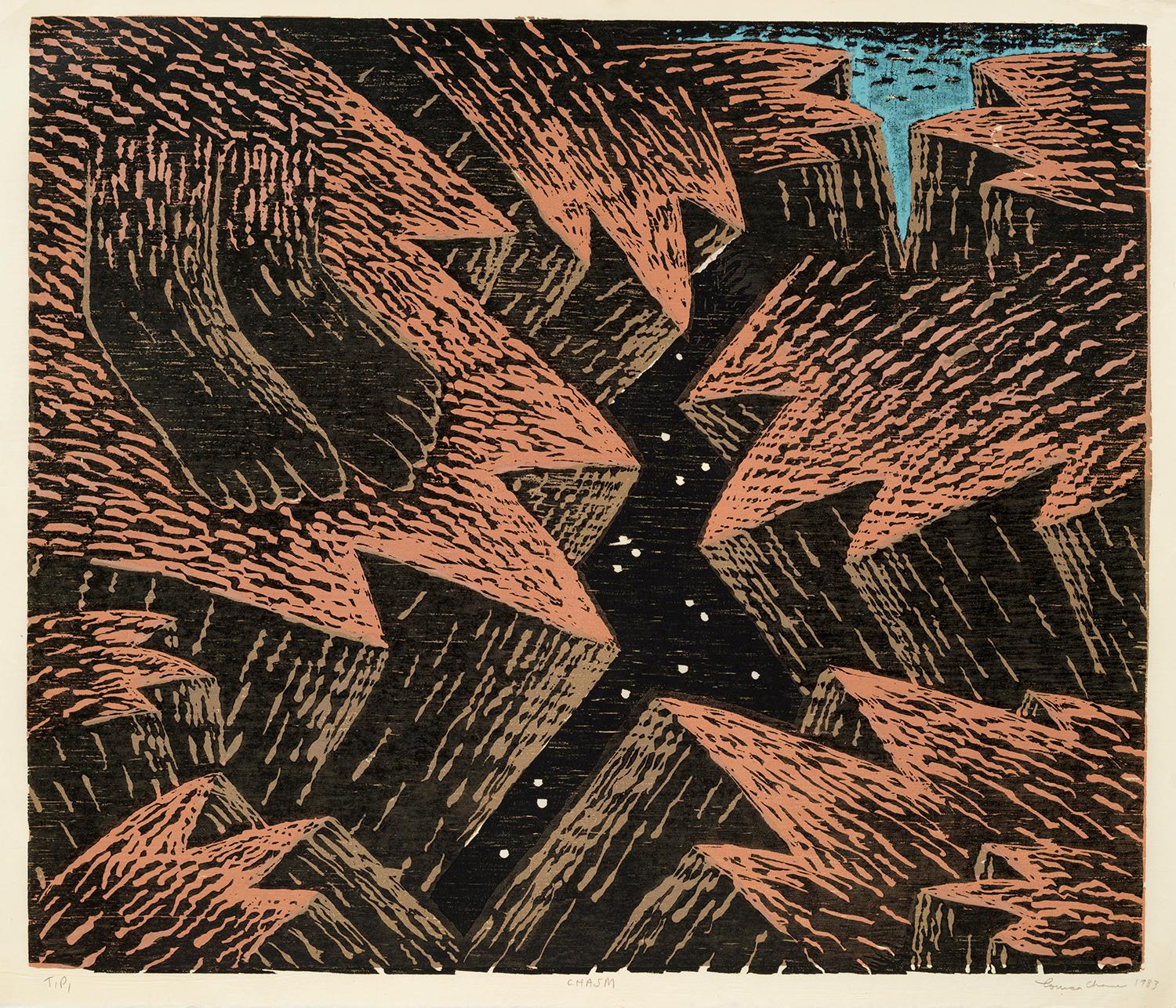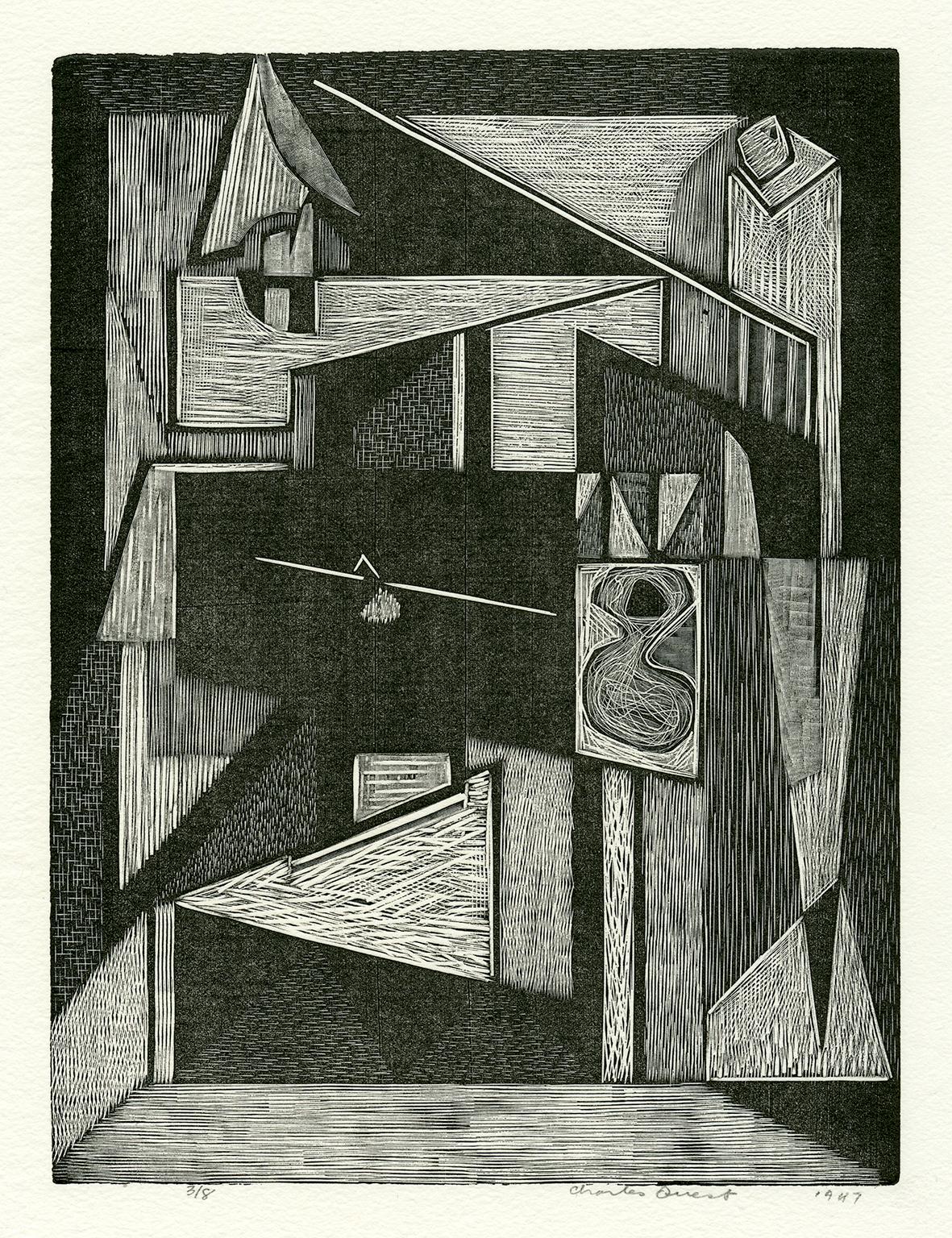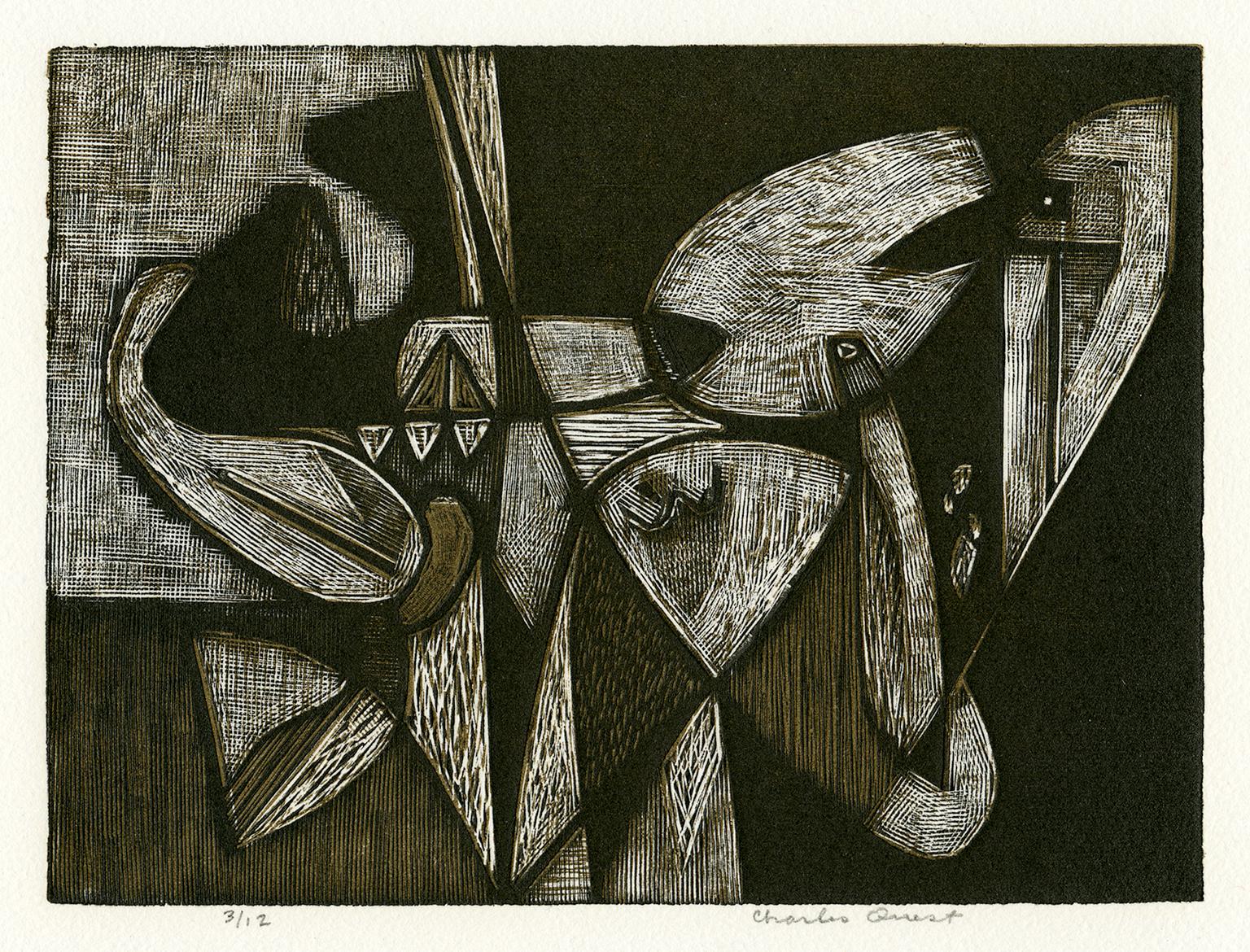Want more images or videos?
Request additional images or videos from the seller
1 of 5
Charles William SmithUntitled1939
1939
About the Item
Untitled
Color woodcut, 1939
Unsigned as issued
Signed and dedicated by the artist on the justification page (see photo)
From:
Abstractions By Charles Smith
Forward by Carl O. Schniewind
Published by The Johnson Company Publishers, New York, 1939
Edition: Unknown
Image size: 9 1/4 x 8 inches
Condition: Slight aging to the wove paper, barely noticeable
Provenance: Isaac Richard Singer, Virginia (see photo)
Alexander Mack Memorial Library, Bridgewater, VA (see photo)
Born in Lofton, Virginia, in 1893, Charles William Smith studied at the University of Virginia summer school, the Corcoran Art School, and Yale University's School of Fine Arts. He taught at the University of Virginia, the College of William and Mary, and the New York School of Printing. Smith moved to Richmond in 1925 where he worked as an artist for Whittet & Shepperson, a local printing firm. In 1929 he taught art at the Richmond Division of the College of William and Mary. For the next four years, Smith worked out of his apartment on Monument Avenue as a commercial artist. He became chair of the art department at Bennington College in Bennington, Vermont, in 1936 and taught there until 1947. Smith taught at the University of Virginia from 1947 until his retirement in 1963 and was the first chairman of the art department. Charles W. Smith died in Charlottesville in 1987.
Smith learned how to use gouges and chisels from his father, a patternmaker for local industries. Early in his career he turned to linoleum block printing. He explained in his 1926 book, Linoleum Block Printing, that the basic techniques for linoleum block and wood block were similar. The artist transferred his design to the block and then cut the design in relief. Areas not to be printed were cut away. The difference lay in the inability of the linoleum to permit fine lines or much detail. Linoleum blocks produced prints with large areas of color and minimal lines.
Carl O. Schniewind (1900-1957)
Curator of Prints and Drawings at the Brooklyn Museum from 1935 to 1940 and Art Institute of Chicago, 1940-1957. Schniewind was the son of a prominent chemical engineer in New York who studied art as a hobby. After the early death of his father, his mother returned to Germany with her two sons in 1914. In Germany he contracted tuberculosis and was treated in a Swiss sanitorium. He studied medicine at the Universities of Zürich and Bern, Switzerland, before changing fields into art history. He received his Ph.D. at the university in Heidelberg, Germany. Schniewind amassed an extensive collection of Daumier graphics and drawings, which he sold at auction in 1933. The same year he married Heidi Bretscher. The couple lived in Paris until 1935, when Schniewind joined the Brooklyn Museum's as librarian and curator of Department of Prints and Drawings, succeeding Susan Hutchinson (q.v.). During his tenure in Brooklyn he oversaw the formation of the Department of Prints and Drawings, which separated from the library collections in 1937. Schniewind acquired important European drawings, including those by Pablo Picasso, Vincent van Gogh, and Edgar Degas. He left the Museum in 1940 to head the Prints department at the Art Institute of Chicago, succeeded in Brooklyn in 1941 by Una Johnson (q.v.). At Chicago, Schniewind mounted the 1941 show "The First Century of Printmaking," writing a catalog with Fogg Museum curator Elizabeth Mongan (q.v.). In 1944, his Posada exhibition was one of the first in the United States to showcase this Mexican graphic artist. Schniewind understood the value of acquiring entire sketchbooks of artists. Under his direction, the AIC's department acquired the sketchbooks of Paul Cèzanne, Odion Redon, James Ensor, Theodore Gèricault and Henri Toulouse-Lautrec, many of which were published as scholarly facsimilies. He also acquired important drawings by Rembrandt, Fragonard and Watteau. While one a buying and research trip in Italy, he died of complications of tuberculosis with which he had struggled his entire adult life. Schniewind was a connoisseur and scholar who took advantage of the works-on-paper art market to acquire magnificent examples of both modern and old-master prints and drawings.
- Creator:Charles William Smith (1893-1987, American)
- Creation Year:1939
- Dimensions:Height: 9.25 in (23.5 cm)Width: 8 in (20.32 cm)
- Medium:
- Movement & Style:
- Period:
- Condition:
- Gallery Location:Fairlawn, OH
- Reference Number:
About the Seller
5.0
Recognized Seller
These prestigious sellers are industry leaders and represent the highest echelon for item quality and design.
Platinum Seller
These expertly vetted sellers are 1stDibs' most experienced sellers and are rated highest by our customers.
Established in 1978
1stDibs seller since 2013
711 sales on 1stDibs
Typical response time: 1 hour
Associations
International Fine Print Dealers Association
- ShippingRetrieving quote...Ships From: Fairlawn, OH
- Return PolicyA return for this item may be initiated within 10 days of delivery.
More From This SellerView All
- UntitledBy Alexander CalderLocated in Fairlawn, OHUntitled Color lithograph, 1966 Unsigned as issued From:Derriere le Miroir, Volume 156 Large unsigned edition Printed by Mourlot, Paris Published by Aime Maeght, Paris Condition: Usu...Category
1960s American Modern Abstract Prints
MaterialsLithograph
- Cleveland Center for Contemporary Art 1968/ 1983By James RosenquistLocated in Fairlawn, OHCleveland Center for Contemporary Art 1968/ 1983 Off-set lithographic poster, 1983 Signed in ink by the artist in the bottom margin (see photo) Poster celebrating the 15 year anniver...Category
1980s American Modern Abstract Prints
MaterialsOffset
- Glowing TreeBy Gabor F. PeterdiLocated in Fairlawn, OHGlowing Tree Etching, engraving & lift ground, 1958 Signed, titled and annotated in pencil (see photos) Edition: Artist Proof (there was a published addition of 30 with five stencil ...Category
1950s American Modern Abstract Prints
MaterialsIntaglio
- Untitled (Plate 2) DLMBy Alexander CalderLocated in Fairlawn, OHUntitled (Plate 2) DLM Color lithograph, 1963 Unsigned and unnumbered (as issued) From: Derriere le Miroir, No. 141 Published by A. Maeght, Paris Printer: Mourlot Freres, Paris Note...Category
1960s American Modern Abstract Prints
MaterialsLithograph
- Untitled (Plate 1) DLMBy Alexander CalderLocated in Fairlawn, OHUntitled (Plate 1) DLM Color lithograph, 1963 Unsigned and unnumbered (as usual) From: Derriere le Miroir, No. 141 Published by A. Maeght, Paris Image/sheet size: 14 7/8 x 11 inches...Category
1960s American Modern Abstract Prints
MaterialsLithograph
- Untitled Double Page Illustration for DLMBy Alexander CalderLocated in Fairlawn, OHUntitled Double Page Illustration for DLM Color lithograph, 1968 Unsigned as issued in DLM Published in Derriere le Miroir (Behind the Mirror), calle...Category
1960s American Modern Abstract Prints
MaterialsLithograph
You May Also Like
- (Abstraction) by DDLocated in New York, NYThis image is an extravaganza of modernist motifs. The monogram 'D.D.' is at the lower right.Category
Mid-20th Century American Modern Abstract Prints
MaterialsWoodcut
- ChasmBy Louisa ChaseLocated in New York, NYLouisa Lizbeth Chase was born in 1951 to Benjamin and Wilda Stengel Chase in Panama City, Panama, where her father, a West Point graduate, was stationed. The family moved to Pennsylv...Category
1980s American Modern Abstract Prints
MaterialsWoodcut
- Untitled (Black Sea)By Louisa ChaseLocated in New York, NYLouisa Lizbeth Chase was born in 1951 to Benjamin and Wilda Stengel Chase in Panama City, Panama, where her father, a West Point graduate, was stationed. The family moved to Pennsylv...Category
20th Century American Modern Abstract Prints
MaterialsWoodcut
- American Landscape: Houses, Gardens and TreesBy Ralph RosenborgLocated in New York, NYSigned (at lower right): Ralph M. Rosenborg 1939; ll: 3/15 WoodcutCategory
Mid-20th Century American Modern Abstract Prints
MaterialsWoodcut
- Work Bench — Mid-century ModernBy Charles QuestLocated in Myrtle Beach, SCCharles Quest, 'Work Bench', 1949, wood engraving, edition 40. Signed, dated and numbered 9/40 in pencil. Titled and annotated 'wood engraving 1949' in pencil, in the artist’s hand, lower right margin. A fine, richly-inked impression, on off-white wove Japan, with full margins (1 3/4 to 2 inches), in excellent condition. Matted to museum standards, unframed. ABOUT THE ARTIST Charles Quest, a successful artist, and fine art instructor, worked in a variety of mediums including mosaic, stained glass, mural painting, and sculpture, but remains best known as a printmaker. Quest grew up in St. Louis, his talent evident as a teenager when he began copying the works of masters such as Michelangelo on his bedroom walls. He studied at the Washington University School of Fine Arts where he later taught from 1944 to 1971. He traveled to Europe after his graduation in 1929, and studied at La Grande Chaumière and Academie Colarossi, Paris, continuing to draw inspiration from the works of the Old Masters. After returning to St. Louis, Quest received several commissions to paint murals in public buildings, schools, and churches, including one from Joseph Cardinal Ritter to paint a replica of Velasquez's Crucifixion over the main altar of the Old Cathedral in St. Louis. Quest soon became interested in the woodcut medium which he apparently learned through his study of J. J. Lankes' A Woodcut Manual (1932) and Paul Landacre's articles in American Artist magazine ‘since no artists in St. Louis were working in wood’ at that time. Quest also revealed that for him, wood cutting and engraving were ‘more enjoyable than any other means of expression.’ In the late 1940s, his graphic works began attracting a lot of critical attention—several of his woodcuts won prizes and were acquired by major American and European museums. His wood engraving entitled ‘Lovers’ was included in the American Federation of Art's traveling print exhibition in 1947. Two years later Quest's two prize-winning prints, ‘Still Life with Grindstone’ and ‘Break Forth into Singing’ were exhibited in major American museums in a traveling show organized by the Philadelphia Print Club. His work was included in the Chicago Art Institute's exhibition, ‘Woodcut Through Six Centuries’ and the print ‘Still Life with Vise’, was purchased by the Museum of Modern Art in New York. In 1951 he was invited by artist-Curator Jacob Kainen to exhibit thirty wood engravings and color woodcuts in the Graphic Arts Division of the Smithsonian's National Museum (now known as the American History Museum). This one-man exhibition was a remarkable achievement for Quest, who had been working in the medium for only about ten years. In the press release for the show, Kainen praised the ‘technical refinement’ of Quest's work: ‘He obtains a great variety of textural effects through the use of the graver, and these dense or transparent grays are set off against whites or blacks to achieve sparkling results. His work has the handsome qualities characteristic of the craftsman and designer.’ At the time of the Smithsonian exhibition, Quest's work was represented by three New York galleries in addition to one in his home town. He had also won 38 prizes, and his prints were in the collections of the Library of Congress, the Chicago Art Institute, the Metropolitan Museum and the Philadelphia Museum of Art. In cooperation with the Art in Embassies program, his color woodcuts were displayed at the American Embassy in Paris in 1951. Recognition at home came in 1955 with his first solo exhibition in St. Louis. Press coverage of the show heralded the ‘growth of graphic arts toward rivaling painting and sculpture as a major independent medium’. Charles Quest retired from teaching in 1971 and made relatively few prints in his later years, as the rigors of the medium were too demanding. He moved to Tryon, North Carolina, with his wife Dorothy, an artist and portrait painter, and remained active as a painter until his death in 1993. An exhibition of his prints at the Bethesda Art Gallery in 1983 attracted the interest of Curator Emeritus Joseph A. Haller, S.J., who began purchasing his work for the University's collection. In 1990 Georgetown University Library's Special Collections Division became the grateful recipient of a large body of Quest's work including prints, drawings, paintings, sculpture, and stained glass, as well as his archive of correspondence and professional memorabilia. These extensive holdings, including some 260 of his fine prints, provide a rich opportunity for further study and appreciation of this versatile and not-to-be-forgotten mid-Western American artist...Category
1940s American Modern Abstract Prints
MaterialsWoodcut
- Underwater — Mid-century ModernBy Charles QuestLocated in Myrtle Beach, SCCharles Quest, 'Underwater', 1948, chiaroscuro wood engraving, edition 12. Signed, titled, dated and numbered '3/12' in pencil. A fine, richly-inked impression, in dark brown and warm black, on off-white wove paper, with full margins (5/8 to 1 1/2 inch), in excellent condition. Scarce. ABOUT THE ARTIST Charles Quest, painter, printmaker, and fine art instructor, worked in various mediums, including mosaic, stained glass, mural painting, and sculpture. Quest grew up in St. Louis, his talent evident as a teenager when he began copying the works of masters such as Michelangelo on his bedroom walls. He studied at the Washington University School of Fine Arts, where he later taught from 1944 to 1971. He traveled to Europe after his graduation in 1929 and studied at La Grande Chaumière and Academie Colarossi, Paris, continuing to draw inspiration from the works of the Old Masters. After returning to St. Louis, Quest received several commissions to paint murals in public buildings, schools, and churches, including one from Joseph Cardinal Ritter, to paint a replica of Velasquez's Crucifixion over the main altar of the Old Cathedral in St. Louis. Quest soon became interested in the woodcut medium, which he learned through his study of J. J. Lankes' A Woodcut Manual (1932) and Paul Landacre's articles in American Artist magazine ‘since no artists in St. Louis were working in wood’ at that time. Quest also revealed that for him, wood cutting and engraving were ‘more enjoyable than any other means of expression.’ In the late 1940s, his graphic works began attracting critical attention—several of his woodcuts won prizes and were acquired by major American and European museums. His wood engraving entitled ‘Lovers’ was included in the American Federation of Art's traveling print exhibition in 1947. Two years later, Quest's two prize-winning prints, ‘Still Life with Grindstone’ and ‘Break Forth into Singing’, were exhibited in major American museums in a traveling show organized by the Philadelphia Print Club. His work was included in the Chicago Art Institute's exhibition, ‘Woodcut Through Six Centuries’, and the print ‘Still Life with Vise’ was purchased by the Museum of Modern Art in New York. In 1951 he was invited by artist-Curator Jacob Kainen to exhibit thirty wood engravings and color woodcuts in a one-person show at the Smithsonian's National Museum (now known as the American History Museum). Kainen's press release praised the ‘technical refinement’ of Quest's work: ‘He obtains a great variety of textural effects through the use of the graver, and these dense or transparent grays are set off against whites or blacks to achieve sparkling results. His work has the handsome qualities characteristic of the craftsman and designer.’ At the time of the Smithsonian exhibition, Quest's work was represented by three New York galleries in addition to one in his home town. He had won 38 prizes, and his prints were in the collections of the Library of Congress, the Chicago Art Institute, the Metropolitan Museum, and the Philadelphia Museum of Art. In cooperation with the Art in Embassies program, his color woodcuts were displayed at the American Embassy in Paris in 1951. Recognition at home came in 1955 with his first solo exhibition in St. Louis. Press coverage of the show heralded the ‘growth of graphic arts toward rivaling painting and sculpture as a major independent medium’. An exhibition of his prints at the Bethesda Art Gallery in 1983 attracted Curator Emeritus Joseph A. Haller, S.J., who began purchasing his work for Georgetown University's collection. In 1990 Georgetown University Library's Special Collections Division was the recipient of a large body of Quest's work, including prints, drawings, paintings, sculpture, stained glass, and his archive of correspondence and professional memorabilia. These extensive holdings, including some 260 of his fine prints, provide a rich opportunity for further study and appreciation of this versatile and not-to-be-forgotten mid-Western American artist...Category
1940s American Modern Abstract Prints
MaterialsWoodcut
Recently Viewed
View AllMore Ways To Browse
William V
Vintage Wood Block Print
Vintage Wood Print Blocks
Pablo Picasso Couple
William Mary Vintage
Wood Block Print Modern
Old Block Prints
Picasso Print Head
Elizabeth Chair
American Wood Block Prints
Vincent Van Gogh Drawings
Alexander Theodore
Theodore And Alexander
Vintage Library Catalog
Color Linoleum
William Singer
William Vincent
German Color Woodcut




